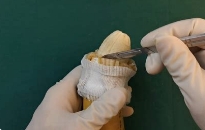
Circumcision is a deeply significant religious and cultural ritual for Muslims around the world. While much attention is given to the ceremony itself, many people wonder: What happens to the cut piece of penis – the foreskin – after a Muslim circumcision? This question, though rarely discussed openly, is important for understanding the cultural, religious, and ethical practices surrounding Islamic circumcision. What Happens to the Removed Foreskin After Muslim Circumcision?
In this article, we will explore the respectful and varied ways the foreskin is handled after circumcision in Muslim communities, the underlying spiritual significance, and how modern medical practices have also influenced this tradition.
The Religious and Cultural Importance of Circumcision in Islam

Circumcision, known as Khitan in Arabic, is considered a Sunnah—a recommended practice—by the majority of Islamic scholars. It is not explicitly mentioned in the Qur’an, but it is strongly emphasized in Hadith (the sayings and actions of the Prophet Muhammad ﷺ). It symbolizes spiritual cleanliness, devotion, and obedience to God.
While the act itself is a momentous milestone in a Muslim boy’s life—often celebrated with a joyful family gathering or religious ceremony—the handling of the removed foreskin is a topic governed by both respect and tradition.
What Happens to the Removed Foreskin?
1. Burial – The Most Revered Practice
In traditional Muslim practice, the most common and honorable method of disposing of the foreskin is burial. This aligns with the general Islamic principle that human body parts should be treated with dignity and respect, even after removal.
- The foreskin is often wrapped in a clean cloth and buried in soil, either near the family’s home, in a garden, or in a designated area like a cemetery.
- In some communities, families may choose to bury it near a mosque or a place of spiritual significance.
- This act is seen as a way of returning the body part to the earth, a symbol of humility and reverence.
The burial of the foreskin is not obligatory in Islamic law, but it is widely considered a respectful and pious practice.
2. Medical Disposal in Modern Settings
In urban areas and developed countries, circumcisions are often performed in hospitals or clinics by medical professionals. In these cases, the foreskin is frequently treated as biological waste and is disposed of according to standard medical protocols.
- The foreskin is placed in a biohazard bag and incinerated along with other surgical waste.
- However, many Muslim families request to take the foreskin home themselves in order to bury it privately, in accordance with their religious values.
Medical disposal is not seen as disrespectful, especially when no alternative is available, but many devout families make an extra effort to follow traditional customs.
3. Ceremonial Handling and Local Customs
In some regions, particularly in Southeast Asia, Africa, and parts of the Middle East, circumcision is surrounded by elaborate ceremonies. While the focus is largely on the child and the ritual, some communities may include prayers, special wrapping, or even symbolic gestures involving the foreskin before it is buried.
- In Turkey, for example, circumcision is a major event with costumes, music, and gifts.
- In Indonesia and Malaysia, certain tribes hold rituals that include spiritual blessings for the child after burial of the foreskin.
These traditions are deeply rooted in local culture and may vary from village to village, but they all reflect the core Islamic value of purity and respect for the human body.
Why Is Respectful Disposal Important in Islam?
Islam places immense value on cleanliness, modesty, and the integrity of the human body. Just as the dead are given a proper funeral and burial, even a small removed part like the foreskin deserves reverent handling. It is a matter of honoring what Allah has created, and ensuring no part of the body is discarded carelessly.
Furthermore, improper disposal (such as throwing it in the trash or flushing it) is generally frowned upon, as it may be seen as disrespectful or spiritually negligent.
Conclusion: Tradition Meets Modernity
The disposal of the foreskin after a Muslim circumcision is far more than a medical afterthought—it is an act rooted in faith, cultural identity, and spiritual mindfulness. Whether buried with prayer or disposed of in a clinical setting, the key principle is respect.
As Muslim families navigate between tradition and modern healthcare, many continue to preserve the sacredness of this rite of passage by choosing to honor every part of the process—including the final resting place of the removed foreskin.